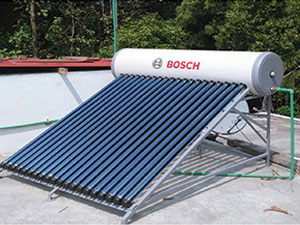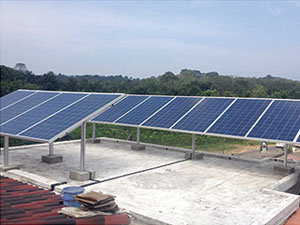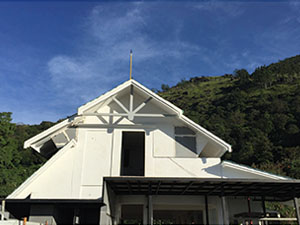-

Solar Water Heater
Solar energy systems require periodic inspections and routine maintenance to keep them operating efficiently. Also, from time to time, components may need repair or replacement. You should also take steps to prevent scaling, corrosion, and freezing.
You might be able to handle some of the inspections and maintenance tasks on your own, but others may require a qualified technician. Ask for a cost estimate in writing before having any work done. For some systems, it may be more cost effective to replace, shut off, or remove the solar system than to have it repaired. -

Solar Power Plants
We use specialist solar photovoltaic test equipment to locate faults and verify that other parts of the installation are performing properly. We also check that your inverter has been set up correctly during commissioning – a common cause of poor yields and faults. All our work is fully guaranteed.
Solar panel system can experience some problems with light production. If your solar panel system is not producing properly, you can troubleshoot it to determine the cause of the problem.
Do a Shading Test: Solar panels require full exposure to light to produce a robust light in the home. If you have noticed that the light production is not as high as normal, you can perform a shade test to determine which of your panels if operating below par. In order to complete a shade test you only need to cover a small portion of the solar panel in question. You can use any item from around your home, such as a large hat or pillow. You will place the object over the panel to shade it from full exposure to light. You will then check to see if the panel is producing less light. Those that do produce less light are sound. The panel that doesn’t respond to the shade test, is the panel that needs repair.
Check the Wiring: More times than not, the problem with your solar panel system is due to faulty wiring. If you installed the system yourself, you can immediately grab your wiring diagram and check each connection. If you don’t find any connections that were done improperly, you can then look for loose connections, corrosion or oxidation.
Loose connections, corrosion or oxidation can cause the electrical system to be compromised. A compromised system often doesn’t produce adequate light. If you find loose connections, you should tighten them. If there is oxidation or corrosion, you will need to remove the damaged areas and install new metal parts.
Check for Heat Fade: Heat fade is when the heat of the sun causes the solar panel system to overheat. Once the system is overheating, you will not get full light production inside your home. If heat fade is the culprit, you will notice a great difference in your system when the sun is at its peak temperature.
If you believe that heat fade is the cause of your solar panel system’s problems, you will need to check for poor wire connections or wire that is too small. If you have to replace the wire, you need to use the heaviest gauge wire that the system will support.
Replace Burnt Terminals: Just like a car battery, solar panel system battery terminals can burn out. When you examine the terminal, you will more than likely find signs of oxidation. This is a sign of a burnt terminal. You will need to replace all metal parts in the terminal. A burnt terminal can be cause by wiring too many panels to one terminal. If you have many panels and just one terminal, you should consider adding a new terminal. -

UPS, Inverter & Battery
The Uninterruptible Power System (UPS) is typically the heart of every electrical power path to business critical loads, thus making UPS Maintenance a necessity. With businesses more dependent today on complex electronic equipment than any other time in history (data processing, IT, process control and communications), making sure this equipment is operational and working at peak efficiency at all times is something we pride ourselves on. The loss of use of any business critical systems can be staggering, financially as well as the potential loss of customer goodwill, especially when compared to the cost of preventive UPS maintenance. The primary purpose of the UPS Preventive Maintenance inspection is to be proactive by ensuring that the UPS, Batteries, and Peripheral components are operating within specifications, all components are in good order and the system will be available to support its critical load, period.
Maintenance services available may include:
Visual Inspections
Voltage Recording
Current Recording
Vacuuming
Cleaning
Waveform Recording
Calibration
Load Bank Testing
UPS batteries should be serviced semi-annually and replaced every 3-5 years, depending on the testing results and environment. The hotter the room the quicker the batteries will fail and require replacement. Manufacturer specifications states keeping the temperate of the room where batteries are stored at 77 degrees F. -

Lightning Protector
We can provide a whole range of lightning protection services including testing, repairs, modifications to existing systems, together with complete new installations. Lightning protection systems should be inspected and tested preferably every year to ensure that they meet legal requirements and recommendations. Lightning strikes are undoubtedly one of the most serious and often overlooked causes of damage to buildings and their contents. More importantly, at its worst a lightning strike can be fatal. Height safe Systems can provide a fully qualified service to ensure that your building, contents and people are protected from such eventuality.
When testing a Lightning Conductor system, it is vital to take into account the seasonal variations. Therefore Height safe Systems recommend that retests are conducted every 11 months. This will ensure that your Lightning Conductor system is fully compliant all year round.
At Height safe Systems we are committed to providing our clients with the best possible service and organisational tools to keep your systems compliant. In order to do this, we provide a variety of services
Tests will be carried out by fully qualified Lightning Protection Technicians and Work at Height specialists
Certificates will be provided showing the readings of each earth electrode position and highlighting the outcome of the test
Reports will be provided to our client with a list of recommendations for improvements required on the Lightning Conductor system
Our in-house CAD Technician will provide you with a drawing indicating where the earth electrode positions are located for future reference
Our operatives will take images before and after any repairs take place.
We can combine Lightning Conductor retests with annual or 6 monthly inspections of your safety lines, eyebolts, abseil points, access ladders, PPE kit or edge protection – saving you money and visits to site.

